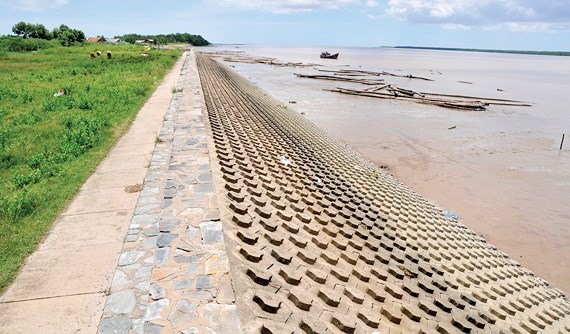 Society
Society

The Ministry of Transport said that building a sea dyke connecting the coastal regions of Bà Rịa-Vũng Tàu and Tiền Giang Provinc would disrupt the planning of seaports, inland waterways and coastal transport.
 |
| The Ministry of Transport opposes the building of a sea dyke connecting the coastal regions of Bà Rịa-Vũng Tàu and Tiền Giang Province, citing its impact on the environment and its low effectiveness. — VNA/VNS Photo Mạnh Linh |
HCM CITY — The Ministry of Transport said that building a sea dyke connecting the coastal regions of Bà Rịa-Vũng Tàu and Tiền Giang Province would disrupt the planning of seaports, inland waterways and coastal transport.
Experts have opposed the Gò Công-Vũng Tàu sea dyke, initially proposed by the Ministry of Agriculture and Rural Development, because of its environmental and economic impact.
According to the transport ministry, the project will seriously affect sea transport, inland waterway transport, and import and export of goods in the region as well as international transshipment.
Meanwhile, the investment of the sea dyke has not been effective, the ministry said, adding that the land fund for the Build-Transfer (BT) project has not been identified.
According to the ministry, the sea dyke would have only small economic benefits in agriculture and aquaculture, and could cause severe losses to the economy and environment.
The ministry also said the dyke would also block the Soài Rạp, Lòng Tàu and Thị Vải estuaries, the country’s three most important gateways for vessels travelling to HCM City and Đồng Nai and Bà Rịa-Vũng Tàu provinces.
This would affect the Cái Mép-Thị Vải seaport and other seaports on the Soài Rạp and Đồng Nai rivers.
The Cái Mép seaport in Bà Rịa-Vũng Tàu is an international gateway seaport which is expected to become the international transshipment port of Southeast Asia.
In addition, the master plan for seaports also identifies Vũng Tàu seaport complex as a gateway for international container transshipment.
The ministry said the construction of the sea dyke would limit circulation flow, reduce depth limit for vessels to travel, limit the ability to transport maritime routes, and create problems for large vessels to reach seaports in the region.
The dyke could lengthen the time for vessels to cross the sea dyke, increasing freight costs and affecting exports.
According to the Việt Nam Union of Science and Technology Associations, the total investment for the Vũng Tàu - Gò Công sea dyke could cost up to VNĐ155.61 trillion (US$6.7 billion).
If the State reciprocal fund contributes 15-20 per cent of the amount, it would be from VNĐ23.3 trillion to VND31,122 trillion of the total investment.
Recently, the Ministry of Agriculture and Rural Development proposed building the Vũng Tàu-Gò Công sea dyke in an effort to combat waterlogging in HCM City.
The proposed Vũng Tàu – Gò Công sea dyke would be extended from Tiền Giang Province’s Gò Công Commune to a point 5km from Bà Rịa - Vũng Tàu Province’s Vũng Tàu City, where it would connect with another dyke 13km long extending to Cần Giờ Biosphere Reserve in HCM City.
The main dyke would be 28km long and 25m wide, with an average water depth of 6.5m. The dyke scale would be 600m to 2000m wide.
In addition to the main dyke, the project includes construction of multiple drainage ditches, a Lòng Tàu sluice, and dams along Đồng Tranh and Soài Rạp rivers.
If approved, it would take 20 to 30 years for the project to be operational, as directed by the Government. — VNS




